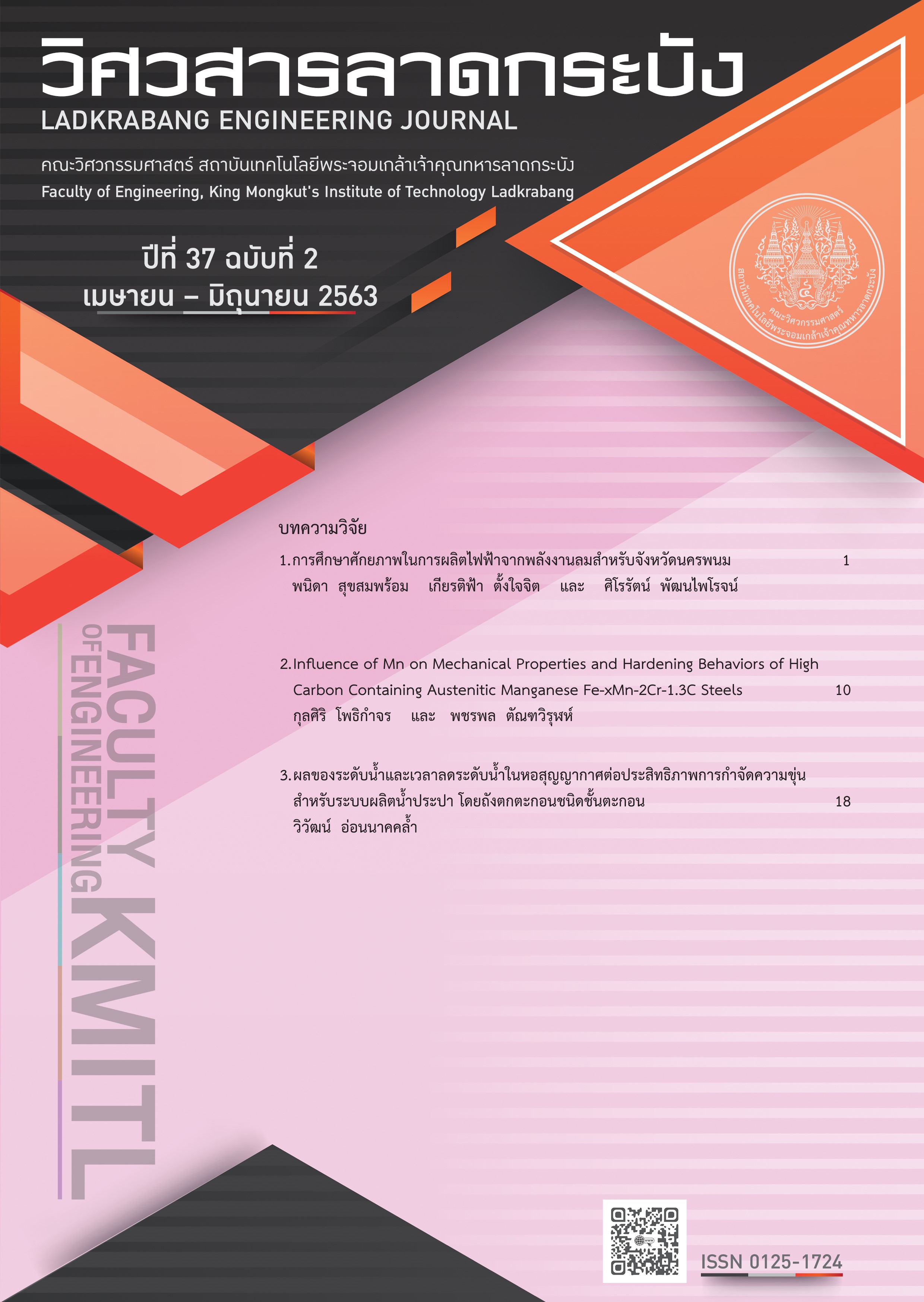Effect of Water Level and Falling Time in Vacuum Chamber on Turbidity Removal Efficiency for Water Treatment by Sludge Blanket Clarifier
Keywords:
Sludge blanket clarifier, turbidity removal efficiencyAbstract
This paper aims to study effect of water level and falling time of vacuum chamber on turbidity removal efficiency for water treatment plant by sludge blanket clarifier. By controlling aluminum sulphate adding rate, 22-mg/l., and surface loading rate, 3.22-m/hr., the results were compare turbidity removal efficiency of water level at 30, 40 and 50 centimeters and falling time at 10, 15 and 20 seconds. Experimental found that water level was not significantly but falling time was significantly affected on turbidity removal efficiency for sludge blanket clarifier. A 15-second of falling time provided higher efficiency than a 10-second and a 20-second of falling time. All Turbidity removal efficiency of a 15-second of falling time was 87.37±1.47%, 87.66±1.27% and 87.26±1.69% for a 30-centimeter, a 40-centimeter and a 50-centimeter of water level, respectively. And, interacted water level and falling time (pulsation rate) was not significantly.
References
T. Wangpaisarn, Water supply engineering, 2th ed., Chulalongkorn University Press, 2003.
C. Chomsuwan, “Improvement turbidity removal efficiency of clarifier in water treatment process,” M.E.dissertation (Industrial Engineering), Kasetsart University, Bangkok, Thailand, 2009.
S. Intrto, “Effect of pulsation rate, surface overflow rate and suction height on turbidity removal efficiency of pulsator clarifier,” M.Sc. dissertation (Environmental Technology), Mahidol University, Nakorn Pathom, Thailand, 2005.
S. M. Khezri, E. Dadvar and H. H. Shekarabi, “A study of the suction height effect on turbidity removal efficiency of water in pulsator,” Global Journal of Researches in Engineering, Vol. 12, pp. 6–12, May, 2012.
S. K. Al-Dawery, R. M. Hussain and K. M. Shibeeb, “Performance of pulsator clarifier (low turbidity),” Iraqi Journal of Chemical and and Petroleum Engineering, Vol. 8, pp. 9–17, March, 2007.
E. L. Sharp, S. A. Parsons and B. Jefferson, “Seasonal variations in natural organic matter and its impact on coagulation in water treatment,” Science of the Total Environment 363, pp. 183–194, June, 2006.
W. Mo, H. Wang and J. M. Jacobs, “Understanding the influence of climate change on the embodied energy of water supply,” Water Research 95, pp. 220–229, March, 2016.
C. C. Dorea, “Coagulant-based emergency water treatment,” Desalination 248, pp. 83-90, May, 2009.
Y. Tantipalakul, K. Palawatwichai, T. Detchakan and, J. Khaisan, “The study of optimal coagulants for water treatment process of Metropolitan Waterworks Authority,” Burabha Journal of Science, Vol. 23, No.1, pp. 207–220, January, 2018.
A. C. Twort, D. D. Ratnayaka and M. J. Brandt, Water supply, 5th ed., Butterworth-Heinamann, 2006.
American Water Work Association and American Society of Civil Engineers, Water treatment plant design, 4th ed., McGraw-Hill, 1990.
Downloads
Published
How to Cite
Issue
Section
License
Copyright (c) 2020 Faculty of Engineering, King Mongkut’s Institute of Technology Ladkrabang

This work is licensed under a Creative Commons Attribution-NonCommercial-NoDerivatives 4.0 International License.
The published articles are copyrighted by the School of Engineering, King Mongkut's Institute of Technology Ladkrabang.
The statements contained in each article in this academic journal are the personal opinions of each author and are not related to King Mongkut's Institute of Technology Ladkrabang and other faculty members in the institute.
Responsibility for all elements of each article belongs to each author; If there are any mistakes, each author is solely responsible for his own articles.






